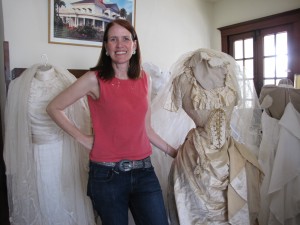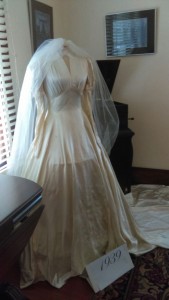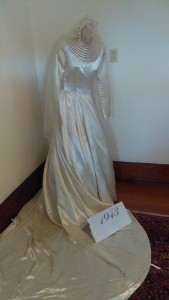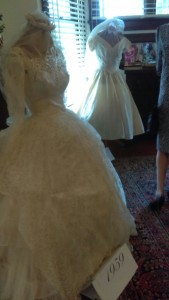Historic wedding gowns reveal the history of women
By Rachel Galvin
On April 2, the Lighthouse Point chapter of Daughters of the American Revolution sponsored a unique event highlighting the changing silhouette of women’s wedding gowns through the years. Besides offering a buffet lunch, the event included a tour of the dresses with speaker Leigh Anne Brown, who has been doing this wedding dress tour for 14 years, 50 presentations per year.
Brown, who came down from Lakeland, FL for the event, said she gets asked three questions every event: 1) How many does she have, 2) Where does she keep them and 3) How did she get started.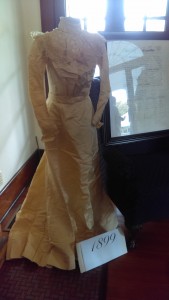
She answered, “I have 160, but brought 27 here. I keep them in a special closet. I store them flat and stack them. They have spent the majority of their lives lying in trunks, storage units… They deserve to be seen. I never intended to do a show. Initially, I collected them for myself, only up until 1930.”
It wasn’t until she was asked to display them at an event that she realized she should begin showing them to people.
“I am a traveling wedding gown road show. Have gown, will travel,” added Brown, who tells about the societal changes for women in America through the stories of the women who once wore the dresses.
She shows off one dress from 1872. The woman who wore it went to college at a time when women were getting higher education for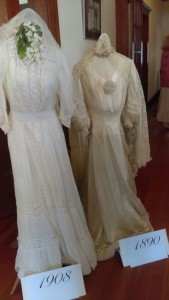 the first time, when women began to understand that they could be more. Yet, this woman still was trapped beneath a steel cage corset and nine layers of clothing surrounding her 19 inch waist. It showcases the rigid rules women were made to follow.
the first time, when women began to understand that they could be more. Yet, this woman still was trapped beneath a steel cage corset and nine layers of clothing surrounding her 19 inch waist. It showcases the rigid rules women were made to follow.
“Women were mad they didn’t have a voice. There was talk about the black man having the right to vote, but not women. After the Civil War, they were left behind, untrained and unprepared. They wanted to make sure their daughters never had to go through what they went through,” she added.
The 1872 dress is not the rarest in her collection, surprisingly. It is actually her dress from 1918. During World War I, she explained, the fewest weddings occurred. People waited until after the war. Unfortunately, many of those men did not come back. So, again, mothers did not want their daughters to go through what they went through, so when World War II came around, women were encouraged to marry and get pregnant before the man went to the war, which led to a spike in 1943 for weddings, and the baby boom when they returned. Weddings became an industry at that time and well-known bridal companies emerged.
One dress’s skirt is actually made from a parachute from the 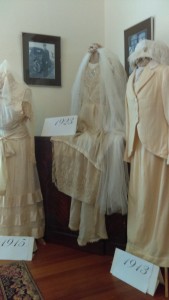 war. The girl was only 15 when her boyfriend went to the war, so her father would not allow her to marry, but they wrote to each other dutifully throughout. When he dropped on D-Day, he kept his parachute. On meeting her at the train station when he returned, he gave her the parachute and said, “Here is the fabric for the dress. We are getting married in two weeks.”
war. The girl was only 15 when her boyfriend went to the war, so her father would not allow her to marry, but they wrote to each other dutifully throughout. When he dropped on D-Day, he kept his parachute. On meeting her at the train station when he returned, he gave her the parachute and said, “Here is the fabric for the dress. We are getting married in two weeks.”
“It shows that even in the middle of destruction and death, love wins,” said Brown.
She added, “When I tell [each bride’s] story, I am telling our story and the story of America. People who listen realize this is their story. It becomes personal.”
“[At] every show, 10 women offer me their wedding dresses,” said Brown, who added that those wanting to donate can e-mail her at lelu22@juno.com.
This event was part of the centennial year events at the Sample McDougald House.
“All of our events are included as part of our Centennial, culminating with a celebration party May 14,” said Museum Manager Lee Waldo. (Look for more info. in The Observer soon).
Brown is a member of the Daughters of the American Revolution. Those interested in joining the Lighthouse Point branch can get more information at https://lighthousepointdar.wordpress.com. Members work to educate people about history, engage in activities that help servicemen and women, veterans and more. They even have scholarships for students and collect books. They meet the first Saturday of every month from September through May.


